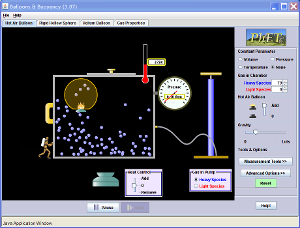Balloons and Buoyancy
A PhET Simulator
An App Lesson by Terry Alexander
An App Lesson by Terry Alexander
The app I choose is a simulator which comes from the PhET project founded by Carl Wileman, who received a NSF Distinguished teacher award, followed soon after by a Nobel prize in physics. He applied the money for both awards to this project with the objective of providing software applications that are meaningful scientific tools for teaching and learning for many topics in science. There are many simulations available. The one I choose is called Balloons and Buoyancy.
I implemented a physics lesson in buoyancy, intended for a high school course in physics with algebra. Ideally this lesson for directly follow a hands on lesson on buoyancy using tissue paper hot air balloons. This is an activity I have done many times and I believe this app lesson will be a very valuable addition to the learning experience.
The lesson plan is detailed in this document, buoyancy lesson plan. There is also a student sheet included here, student sheet on buoyancy. This lesson plan was adapted from content provided from the UTeach outreach program at the University of Texas at Austin, outreach document.
TPACK Framework (Technological Pedagogical and Content Knowledge)
Technology: Students will use a pc or a MC, either available in the room or in a computer lab. The app is a simulated buoyancy chamber with controls for volume, temperature, and pressure. The app is an interactive Java app where the students click and experiment with different factors in the simulation. Unfortunately, app uses full Java app support which is not yet available on tablets.
Pedagogy:
The pedagogy used is that is Guided Discovery. The student is presented with a rich environment with the simulator where they can run their own experiments.The lesson includes some guidance to set them in the right direction. The relationship between temperature, pressure, volume and buoyancy is learned by direct exploration.
The pedagogy used is that is Guided Discovery. The student is presented with a rich environment with the simulator where they can run their own experiments.The lesson includes some guidance to set them in the right direction. The relationship between temperature, pressure, volume and buoyancy is learned by direct exploration.
Content:
The content presented includes knowledge of the states of matter at a molecular level. The mathematical relationship between pressure, volume, temperature, and buoyancy as also presented and built into the simulation.
The content presented includes knowledge of the states of matter at a molecular level. The mathematical relationship between pressure, volume, temperature, and buoyancy as also presented and built into the simulation.
Combined:
These three aspects of TPACK are melded as the content is built into the simulator so that it can mathematically and graphically model the buoyancy as a virtual experiment. The use of computers is necessary, this model cannot be made in real life, it is a simulator at the molecular level which cannot be directly observed in the way this model presents it. The presentation of the app encourages a scientific exploration of the content and supports a guided exploration learning experience for the students.
This lesson falls in the Redefinition category, described as "Computer technology allows for new tasks that were previously inconceivable." The app enables the student to conceptualize and experiment with a model of pressure, temperature, and buoyancy at a molecular level. It is an interactive model which allows the student to explore the relationship between these variables as a scientist would. This experience is not possible without technology.

No comments:
Post a Comment